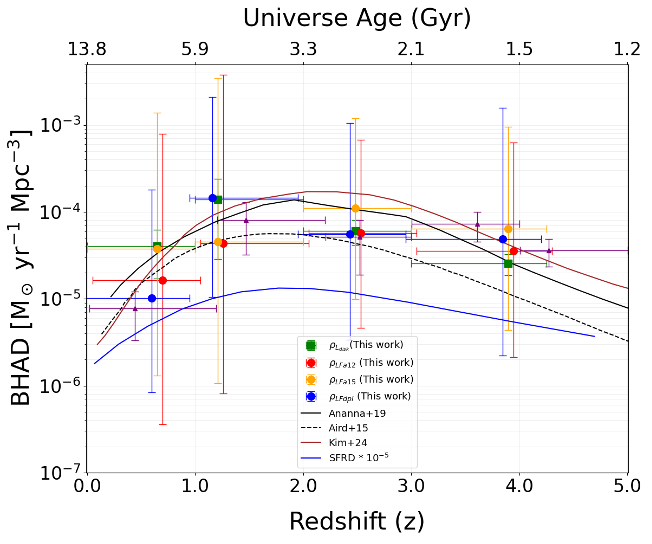This study presents the black hole accretion history (BHAH) of obscured active galactic nuclei (AGNs) identified from the JWST CEERS survey by Chien et al. (2024) using mid-infrared (MIR) spectral energy distribution fitting. We compute black hole accretion rates (BHARs) to estimate the black hole accretion density (BHAD) across redshifts 0 to 4.25. MIR luminosity functions (LFs) are also constructed for these sources, modeled with modified Schechter and double power-law forms. The corresponding BHAD is derived by integrating the LFs and multiplying by the luminosity. Both luminosity-function-based BHAD estimates extend to luminosities as low as 10⁷ solar luminosities, two orders of magnitude fainter than pre-JWST studies.
Our results show that BHAD peaks between redshifts 1 and 3, with the exact peak depending on the method and model: around redshift 1–2 for the accretion-density method and the double power-law model, and around redshift 2–3 for the modified Schechter function. A scenario where AGN activity peaks before cosmic star formation would challenge existing black hole formation theories, but our present study, based on early JWST observations, provides an initial exploration of this possibility. At redshift ~3, the luminosity-function-based BHAD appears higher than X-ray estimates, suggesting that MIR observations are more effective in detecting obscured AGNs that X-ray observations miss. However, given the overlapping error bars, this difference remains within the uncertainties and requires confirmation with larger samples.
These findings highlight the potential of JWST surveys to enhance our understanding of the co-evolution between galaxies and AGNs.
A.C. acknowledges the Taiwan Astronomical Research Alliance (TARA) and it's summer
student internship program for partial financial support of this research.
References
Yang, G, KI Caputi, C Papovich, P Arrabal Haro, MB Bagley, P Behroozi, EF Bell, L Bisigello, V
Buat, D Burgarella, et al. 2023. Ceers key paper. Vi. jwst/miri uncovers a large population of
obscured agn at high redshifts. The Astrophysical journal letters 950 (1): L5
Chien, Tom C-C, Chih-Teng Ling, Tomotsugu Goto, Cossas K-W Wu, Seong Jin Kim, Tetsuya
Hashimoto, Yu-Wei Lin, Ece Kilerci, Simon C-C Ho, Po-Ya Wang, et al. 2024. Finding dusty
agns from the jwst ceers survey with mid-infrared photometry.
Monthly Notices of the Royal Astronomical Society 532 (1): 719–733.
Ananna, Tonima Tasnim, Ezequiel Treister, C Megan Urry, Claudio Ricci, Allison Kirkpatrick,
Stephanie LaMassa, Johannes Buchner, Francesca Civano, Michael Tremmel, and Stefano
Marchesi. 2019. The accretion history of agns. i. supermassive black hole population synthesis
model.
The Astrophysical Journal 871 (2): 240.
Kim, Seong Jin, Tomotsugu Goto, Chih-Teng Ling, Cossas KW Wu, Tetsuya Hashimoto, Ece
Kilerci, Simon CC Ho, Yuri Uno, Po-Ya Wang, and Yu-Wei Lin. 2024. Cosmic star-formation
history and black hole
accretion history inferred from the jwst mid-infrared source counts.
Monthly Notices of the Royal Astronomical Society 527 (3): 5525–5539.
